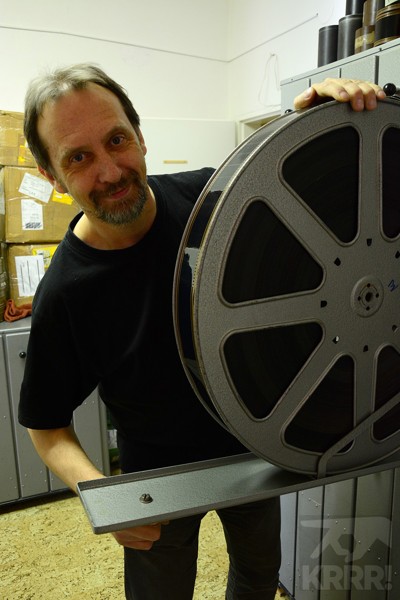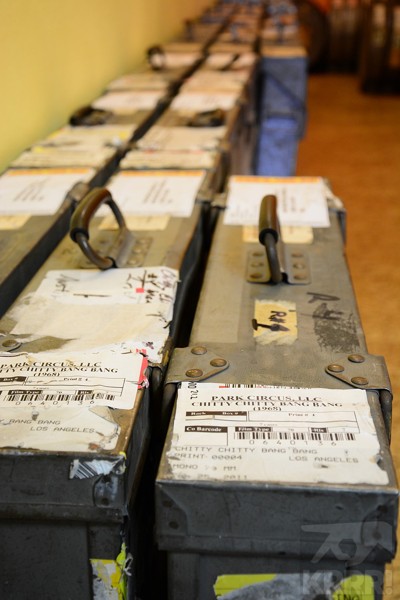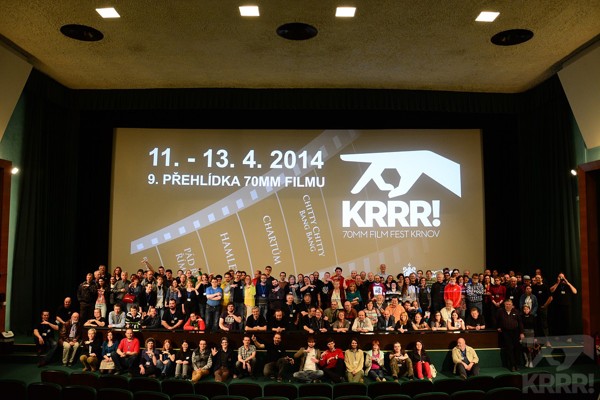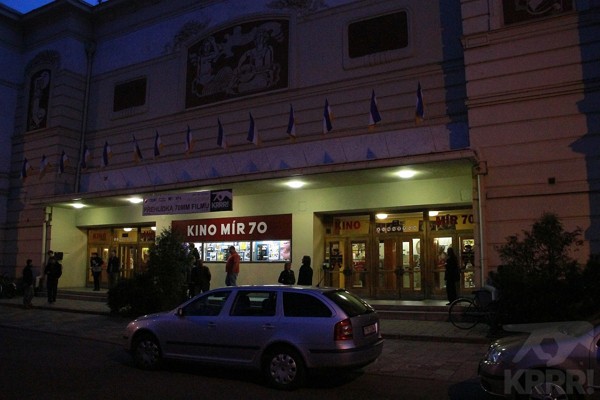|
| |
Krrr! Means not only Krnov, but also a sound of roaring
film projector
Remarks of a visitor |
Read more at
in70mm.com
The 70mm Newsletter
|
|
Written by:
Stanislav Novotný |
Date: 28.06.2014. |
 Pavel
Tomesek, the chief projectionist of Krnov Mir 70 cinema and the spirit
of KRRR! Pavel
Tomesek, the chief projectionist of Krnov Mir 70 cinema and the spirit
of KRRR!
During
past nine years a new tradition has been established for Czech 70mm film
fans in North-Moravian city of Krnov. When mid-April comes, flowers
start to be in bloom and days are longer and longer – those are not only
marks of forthcoming spring – it is also an inviting enticement for real
film connoisseurs from Czech Republic, Slovakia, Poland and other not
only neighbouring countries. There's a categorical imperative: “Let's go
to Krnov.” A very positive circumstance could be seen in fact that this
unique event gathers people from various companies oriented to film from
various aspects – schools, institutions, archives, studios, labs – and
joins people of ages from young students, up to matured experts.
A three-day Marathon of 9th KRRR 2014 took place from Friday, 11th April
till Sunday 13th April. Nine 70mm film titles, more than 50 km of 70mm
film strips and more than 25 hours of pure time in darkened cinema moved
real film feeders to heavenly nice cinematic euphoria.
The program opened Soviet historical drama The Flying Hussars
Squadron filmed in Sovscope 70. This print was made on a Soviet
positive film stock called Svema. Although its spectrum is generally
considered as full coloured, it has to be modified to full “Russian
colour spectrum”. Telling the truth there are not such remarkable
changes of dyes as are usually visible on older prints made on Eastman
Color Print, however this particular colour spectrum was also somehow
changed. It means that flesh tones are unnaturally pale, lights are
bluish and overall colour saturation is lower than corresponds to a
correct colour reproduction. This is a general portrayal of Russian film
colour response, although not all Soviet prints weren't made on Svema
stock, but also on the East-German Orwocolor Positive film material.
Second listed film followed later in the afternoon was American musical
Chitty Chitty Bang Bang filmed in Super Panavision 70. This
feature wasn't ever released in former Czechoslovakia (or now in the
Czech Republic) before. The showed print had almost magenta dye
remained. That means the image was quite reddish or pink but surely the
plot of the film based on Ian Fleming's novel and Roald Dahl's
screenplay, nice Chitty Chitty Bang Bang song and English humour
stood still distinct.
|
More
in 70mm reading:
• Home of "7OMM Seminar" at Kino Mir 70, Krnov, Czech
Republic
KRRR! 9th 70mm Film Fest Krnov 2014
7OMM Seminar Through the Years:
• Film Program
• Text and Image
About Todd-AO
•
Počátky
Todd-AO
Internet
Kino Mir 70
Namesti Miru 14
794 01 Krnov
The Czech
Republic
Telephone: +420 554 615 050
Head of the Kino Mir 70:
Pavel Tomešek
• Festival Page
•
KRRR! Facebook
|
 Containers
with kilometers of 70mm films utilize most every free space in the
technical compartment of the cinema Containers
with kilometers of 70mm films utilize most every free space in the
technical compartment of the cinema
The
evening program opened an official address of Krnov Mayor Mrs. Alena
Krušinová. After this formal opening a third film was threaded into a
pair of Meopta UM70/35 projectors in the Mír 70 cinema. It was a
premiere show of the Ultra-Panavision 70 print of Khartoum in its
full aspect ratio of 1 : 2.76. This show was made possible thanks to Mr.
Herbert Born, who kindly lent his Ultra-Panavison projection lenses to
the Krnov Mír 70 cinema for this special event. In fact the Mír 70
cannot exploit wider screen than the installed 15-meter-wide one. To fit
the image of Khartoum in 1 : 2.76 aspect ratio onto this screen
means that the projected image was a little bit lower. Using a
television terminology it could be described as a letterbox format on a
screen of 1 : 2.2 ratio.
When Khartoum finished a traditional Friday evening bash in the
foyer of the cinema was arranged. This is always a good opportunity not
only as a refreshment of hungry a thirsty viewers but also a unique
chance for meetings friends and talks to other film fans, because usual
breaks between films are not long enough for such purposes and film fans
have always much to talk about their movie experience.
Late night show belonged to brave Indiana Jones, who personally visited
the cinema with his typical broad hat on his head and a with a whip in
his hand to introduce the third movie of “his” series – Indiana Jones
and the Last Crusade. This movie originally filmed in anamorphic
35mm Panavision was the only one blow-up title shown at this festival
and was projected without Intermission. Other 70mm films on the Fest had
traditional Intermissions, which are inherent parts of pristine 70mm
movies.
|
Internet link:
TV Report
Festival Page
Kino Mir 70
Namesti Miru 14
794 01 Krnov
The Czech Republic
Telephone: +420 554 615 050
Head of the Kino Mir 70: Pavel Tomešek
Official 70mm Festival Page
www.krnov.cz
ACFC
YouTube clip
|
 Accreditations
in the lobby of the Kino Mir 70 cinema Accreditations
in the lobby of the Kino Mir 70 cinema
Short
night left and Saturday morning dragged viewers to another long film run
again. The first movie shown on Saturday was Russian (Soviet) film
Tchaikowski, a biographical story of a famous Russian composer.
Heavy dark atmosphere of Russian society of 19th century and inner
struggles of Tchaikowski – that is a brief report of this film. Its
colour spectrum corresponds to parameters described above.
Early afternoon opened a video clip made by Polish Guru group together
with Czech film enthusiasts showing their individual vision of the KRRR
Festival. A historical drama - the classic Shakespeare's play Hamlet
in an unusual arrangement of Kenneth Branagh – followed after this
extraordinary clip. Long, but well done notorious story transposed to
19th century could be found as a pretty much talkative film with more
than four hours of projection time with three thousand of subtitles.
|
|
 Official
on-stage photo Official
on-stage photo
Early
Saturday evening another historical drama took place on the Mír 70
screen: The Fall of the Roman Empire, another Ultra-Panavision 70
film, but in a difference to Khartoum, this print was optically
unsqueezed, transformed to regular spherical 70mm screening in 1 : 2.2
format. Stellar cast, spectacular show and stunning exterior set of
Forum Romanun however could not balance more or less boring plot. Colour
shift of the film image to reddish tones due to its olden date of the
print was very apparent.
Late night show took viewers to Ireland during a period of world war one
in an amorous story of Ryan's Daughter. Masterful direction of
David Lean and fine cinematography of Freddie Young didn't allow to
sleep to outspent viewers, although this three-hour drama run in a very
late night time. This show was possible thanks to Hans Hänßer, who
kindly loaned this print in German dubbing. In addition to this there
was one more very late night unscheduled bonus. After the Ryan's
Daughter we've got a unique opportunity to see a half-hour Soviet
Kinopanorama promo picture similar to This Is Cinerama, but Made in
USSR. The 70mm print integrated three original separate 35mm
Cinerama-like strips. Colour degradation to pink tones indicated that
this print was made on the Eastman Colour Print stock. Film was narrated
into English. Composite Cinerama-like image proved similar handicaps as
original Cinerama, but in a more apparent form, i.e. connection,
unsteadiness and disparity of photographic quality of particular images
were more disruptive than such ones in its American counterpart.
|
|
 Early
Saturday nighto in front of the Kino Mir 70 Early
Saturday nighto in front of the Kino Mir 70
Sunday morning attracted real film patrons, who are interested in film
technology. They were amply rewarded by a perfect lecture devoted to a
history of film sound systems of Mr. Ivan Školuda, the author, who had
prepared a very good one-hour discourse supported by virtual
demonstrations of various sound systems from a very past history up-to
present days.
Regular
Sunday film program had started at 10.30 A. M. The third Russian
film presented on this show Anna Karenina (1967) was
screened. A famous story based on a Lev Nikolayevich Tolstoy's novel
is well-known not only as a literary original, but also thanks to
various film adaptations. This one was made in the USSR in 1967 by
Alexander Zarchi with Tatyana Samoylova in a title role. This third
Russian (Soviet) film screened on 9th KRRR was the best one in the
Russian series (according to opinion of the author). Nevertheless it
also suffered with the same technical problems as other two Russian
ones that mean typical desaturated colour reproduction as well as
visible low resolution of large format image, despite of the fact
that the original negative was shot on a 70mm film stock. In a
difference to Todd-AO and Super Panavision 70, which had used 65mm
negative, Soviet Sovscope 70 exploited both negatives and prints in
70mm width.
Sunday afternoon and early evening brought reprises of two films
shown first on Friday: Chitty Chitty Bang Bang and
Khartoum.
Well, 9th KRRR is over, let's look forward to the jubilee 10th KRRR
2015 (17th to 19th April 2015)!
More details of screened films here
KRRR! 9th 70mm Film Fest Krnov 2014.
More photos are available on
Facebook.
|
|
| |
|
Go: back - top -
back issues - news index
Updated
22-01-2025 |
|
|
|